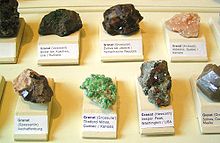- Museum für Naturkunde
-
Coordinates: 52°31′48″N 13°22′46″E / 52.530020°N 13.379514°E
Museum für Naturkunde 
Established 1810 Location Invalidenstrasse 43
10115 Berlin
GermanyType Natural history museum Director Dr. Ferdinand Damaschun (acting director)[1] Website http://www.naturkundemuseum-berlin.de/index_english.html The Museum für Naturkunde, officially the Museum für Naturkunde – Leibniz-Institut für Evolutions- und Biodiversitätsforschung an der Humboldt-Universität zu Berlin (Museum für Naturkunde – Leibniz Research Institute for Evolution and Biodiversity at the Humboldt University Berlin) or Naturkundemuseum (Natural History Museum), occasionally known as the Humboldt Museum, is a natural history museum in Berlin, Germany. Usually the museum's name is abbreviated MFN, but other shorts are common in the older literature, too. The museum houses a massive collection of more than 30 million zoological, paleontological, and mineralogical specimens, including more than ten thousand type specimens. It is most famous for two spectacular exhibits: the largest mounted dinosaur in the world, and the most exquisitely preserved specimen of the earliest known bird, Archaeopteryx.
This is the largest museum of natural history in Germany, and was established in 1810. Its collections contain objects from three major fields, paleontology, mineralogy, and zoology. The museum's mineral collections date back as early as to the Prussian Academy in 1700. Significant zoological specimens were recovered for example by the German deep-sea Valdiva expedition (1898–99), by the German Southpolar Expedition (1901–03), and by the German Sunda Expedition (1929–31). Expeditions to fossil beds in Tendaguru in former Deutsch Ostafrika (today Tanzania) unearthed rich paleontological treasures. The collections are so extensive that less than 1 in 5000 specimens is actually exhibited, and they attract researchers from around the world.
Additional exhibits include a mineral collection representing 75% of the minerals in the world, a large meteor collection, the largest piece of amber in the world; exhibits of the now-extinct quagga and tasmanian tiger, and "Bobby" the gorilla, a Berlin Zoo celebrity from the 1920s and 1930s.
Contents
Exhibitions
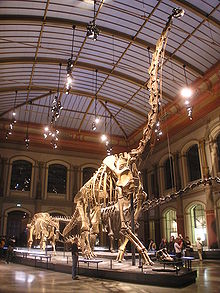 The Dinosaur Hall seen from the entrance, with the skeleton of Giraffatitan (formerly Brachiosaurus) brancai in the center
The Dinosaur Hall seen from the entrance, with the skeleton of Giraffatitan (formerly Brachiosaurus) brancai in the center
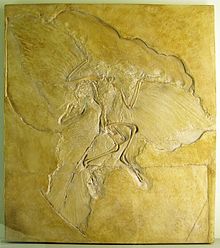 The 'Berlin Specimen' of Archaeopteryx
The 'Berlin Specimen' of Archaeopteryx
The exhibition at the MFN covers all aspects of natural history, including displays of mineralogical, paleontological and zoological specimens. Since the museum renovation in 2007, a large hall explains biodiversity and the processes of evolution, while several rooms feature regularly changing special exhibitions.
Dinosaur Hall
The specimen of Giraffatitan brancai[2] in the central exhibit hall is the largest mounted dinosaur skeleton in the world.
It is composed of fossilized bones recovered by the German paleontologist Werner Janensch from the fossil-rich Tendaguru beds of Tanzania between 1909 and 1913. The remains are primarily from one gigantic animal, except for a few tail bones (caudal vertebrae) which belong to another animal of the same size and species.
The mount is 12.72 m (41 ft 5 in) tall, and 22.25 m (73 ft) long (as of 2005). When living, the long-tailed, long-necked herbivore probably weighed 50 t (55 tons). While the Diplodocus carnegiei mounted next to it (a copy of an original from the Carnegie Museum of Natural History in Pittsburgh, United States) actually exceeds it in length (27 m, or 90 ft), the Berlin specimen is taller, and far more massive.
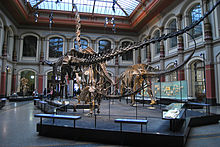 The Dinosaur hall, reverse view. Kentrosaurus in the foreground, Diplodocus, Giraffatitan and Dicraeosaurus from left to right in the back.
The Dinosaur hall, reverse view. Kentrosaurus in the foreground, Diplodocus, Giraffatitan and Dicraeosaurus from left to right in the back.
Archaeopteryx
The "Berlin Specimen" of Archaeopteryx lithographica (HMN 1880), is also displayed in the central exhibit hall. The dinosaur-like body with an attached tooth-filled head, wings, claws, long lizard-like tail, and the clear impression of feathers in the surrounding stone is strong evidence of the link between reptiles and birds. The Archaeopteryx is a transitional fossil; and the time of its discovery was apt: coming on the heels of Darwin's 1859 magnum opus, The Origin of Species, made it quite possibly the most famous fossil in the world.
Recovered from the German Solnhofen limestone beds in 1871, it is only the third Archaeopteryx to be discovered and the most complete. The first specimen, a single 150 million year old feather found in 1860, is also in the possession of the museum.
Minerals Halls
The MFN's collection comprises roughly 250.000 specimens of minerals, of which roughly 4.500 are on exhibit in the Hall of Minerals.[3][4]
Evolution in action
A large hall explains various principles of evolution. It was opened in 2007 after a major renovation of parts of the building.
History
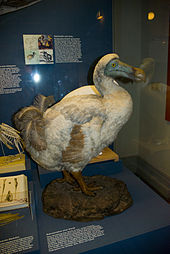 A stuffed Dodo
A stuffed Dodo
Minerals in the museum were originally part of the collection of instructors from the Berlin Mining Academy. The University of Berlin was founded in 1810, and acquired the first of these collections in 1814, under the aegis of the new Museum of Mineralogy. In 1857, the paleontology department was founded, and 1854 a department of petrography and general geology was added.
By 1886 the University was overflowing with collections, so design began on a new building nearby at Invalidenstraße 43, which opened as the Museum of Natural History in 1889. The museum was built on the site of a former ironworks and this is reflected in two spectacular cast iron stairwells within the building.
Of particular significance is the contribution of the first director after the move to the new building. In the past the museum simply consisted of the entire collections being open to the public, but Karl Möbius instigated a clear split between a public exhibition space with a few choice specimens, together with explanations of their relevance, and the remainder of the collection held in archives for scientific study. This scheme was adopted by all other natural history museums.
The collections were damaged by the Allied bombing of Berlin during World War II. The eastern wing was severely damaged, and is only now in the process of being rebuilt. From 2010, is planned to house the entire alcohol collections in the east wing under fully modern conditions of specimen storage.
In 1993, after the shake-up caused by the reunification of Germany, the museum split into the three divisions: The Institutes of Mineralogy, Zoology, and Paleontology. Infighting between the institute directors led to important changes in 2006, which saw the appointment of a Director General and the replacement of the former institutes by a division into Collections, Research and Exhibitions. Since January 1st, 2009 the Museum has officially separated from the Humboldt-University and become part of the Gottfried Wilhelm Leibniz Scientific Community as the Museum für Naturkunde – Leibniz Institute for Research on Evolution and Biodiversity at the Humboldt University Berlin (German: Museum für Naturkunde – Leibniz-Institut für Evolutions- und Biodiversitätsforschung an der Humboldt-Universität zu Berlin). It is legally set up as a foundation.
Footnotes
- ^ "Organisation" (HTML). Museum für Naturkunde Berlin. http://www.naturkundemuseum-berlin.de/ueber_uns/ueberuns_6300.html.
- ^ Gregory S. Paul formally moved the Brachiosaurus brancai species to a new subgenus (Giraffatitan) in 1988, and George Olshevsky promoted the new taxa to genus in 1991. Although the change has been generally accepted among scientists, as of 2011 the museum's labels still use the old genus name.
- ^ Süddeutsche Zeitung Online Wissenschaft im Paradies - Schöner forschen, accessed 9.9.2011
- ^ MFN entry in the database University museums and collections in Germany of the Hermann von Helmholtz-Zentrums für Kulturtechnik, Humboldt-Universität zu Berlin, accessed 9.9.2011
References
- Olshevsky, G. (1991). "A Revision of the Parainfraclass Archosauria Cope, 1869, Excluding the Advanced Crocodylia". Mesozoic Meanderings #2 1 (4): 196 pp.
- Paul, G. S. (1988). "The brachiosaur giants of the Morrison and Tendaguru with a description of a new subgenus, Giraffatitan, and a comparison of the world's largest dinosaurs". Hunteria 2 (3): 1–14.
- Maier, Gerhard. African dinosaurs unearthed : the Tendaguru expeditions. Bloomington, Indiana : Indiana University Press, 2003. (Life of the Past Series).
External links
- Museum für Naturkunde (home page)
- Naturkundemuseum Berlin seeks sponsors for a hoard of world heritage treasures, by Eva-Maria Levermann from Goethe-Institut
- History of Humboldt-Universität zu Berlin
- Photo of the Berlin specimen of the Archaeopteryx
- History of the mineralogical collections at the Museum of Natural History in Berlin
- Time-lapse film of the dismantling of Brachiosaur
- History of the mineral collection
Categories:- Museums established in 1810
- Museums in Berlin
- Natural history museums in Germany
- Humboldt University of Berlin
- University museums in Germany
Wikimedia Foundation. 2010.

